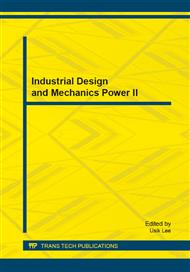[1]
Gao Deping, Zhang Yisong. A Dynamic Characteristic Analysis of A Bladed Disk Assembly[J]. 1988, 3(2): 97-101.
Google Scholar
[2]
Song Zhaohong. Strength Design of aircraft engine[M]. Beijing, (1988).
Google Scholar
[3]
J.Η. Griffin, Friction Damping of Resonant Stresses in Gas Turbine Airfoils, ASME Journal of Engineering for Power, 1980, 102 (2), 329-333.
DOI: 10.1115/1.3230256
Google Scholar
[4]
J. T. Oden, C. H. Menq. Characterization of Contact Kinematics and Application to the Design of Wedge Dampers in Turbo-machinery Blading: Part 1-Stick-Slip Contact Kinematics[J], Journal of Engineering for Gas Turbine and Power, 4(120), 410-417(1998).
DOI: 10.1115/1.2818138
Google Scholar
[5]
J. T. Oden, C. H. Menq. Characterization of Contact Kinematics and Application to the Design of Wedge Dampers in Turbo-machinery Blading: Part2-Prediction of Forced Response and Experimental Verification [J], Journal of Engineering for Gas Turbine and Power, 4(120): 410-417(1998).
DOI: 10.1115/1.2818139
Google Scholar
[6]
Iwan W D. On a Class of Models for the Yielding Behavior of Continuous and Composite Systems[J]. ASME Journal of Applied Mechanics, 1967, 89(6): 612-617.
DOI: 10.1115/1.3607751
Google Scholar
[7]
Segalman D J. An initial overview of Iwan modeling for mechanical joints[R]. New Mexico, USA: Sandia National Laboratories, Technical Report SAND2001-0811, (2001).
Google Scholar
[8]
C.H. Menq, J. Bielak, J. H. Griffin, The influence of micro-slip on vibratory response, part І: a new micro-slip model[J], Journal of Sound and Vibration(1986), 107(2): 279-293.
DOI: 10.1016/0022-460x(86)90238-5
Google Scholar
[9]
L.E. Goodman, J.H. Klumpp, Analysis of Slip Damping with reference to Turbine Blade Vibration, ASME Journal of Applied Mechanics, 1956, 23(3): 421-429.
DOI: 10.1115/1.4011348
Google Scholar
[10]
Qi Wenkai, Gao Deping, Study of Vibration Response Method for the Dry Friction Damping System[J], Journal of Aerospace Power, 2006, 21(1): 161-167.
Google Scholar
[11]
Xu Zili, Chang Dongfeng, Liu Yaling, Forced response analysis of blade system with dry friction damper using one-bar micro-slip analytic model[J], Journal of Vibration Engineering, 2008, 21(5): 505-510.
Google Scholar
[12]
Wang Xiaoning, Chen Yong, Du Zhaohui, Numerical Simulation of the Vibration Characteristics for the Blade with Zigzag Shroud. [J], 30(8), 589-606(2010).
Google Scholar
[13]
Valentin L. Popov. Contact Mechanics and Friction Physical Principles and Application[M], Beijing, Tsinghua University Press, (2011).
Google Scholar
[14]
B Shangguan, Z Xu, Experimental study of friction damping of blade with loosely assembled dovetail attachment[J]. Journal of Power and Energy, 2012, 226(6): 738-750.
DOI: 10.1177/0957650912453536
Google Scholar


